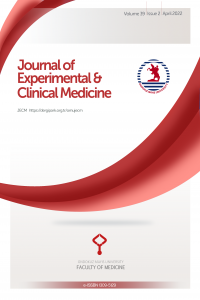Abstract
Supporting Institution
yok
References
- 1.Lopez- Barcenas A, Contereras-Ruiz J, Carrillo-Correa M. Dermatosis cenicienta (Eritena discromico perstans). Med Cutan Iber Lat Am 2005;33:97-102.
- 2.Karaarslan IK, Türkmen M, Kandiloğlu G, Kazandı AC, Alper S. Erythema dyschromicum perstans: a case report (Bir eritema diskromikum perstans olgusu). Turkiye Klinikleri J Dermatol 2008;18:199-202.
- 3. Angel FF, Manual G, Montero C. Ashy dermatosis, or “Tyndall-effect” dermatosis. Dermatol Online J 2008;12(4):14.
- 4.Bahadir S, Cobanoglu U, Cimsit G, Yayli S, Alpay K. Erythema dyschromicum perstans: response to dapsone therapy. Int J Dermatol 2004;43:220-222.
- 5. Cutrì FT, Ruocco E, Pettinato G, Ciancia G. Lichen planus pigmentosus-like ashy dermatosis. Dermatol Reports. 2011;3(3):e46
- 6.Tlougan BE, Gonzalez ME, Mandal RV, Kundu RV, Skopicki D. Erythema dyschromicum perstans. Dermatol Online J. 2010;16(11):17.
- 7. Akbas, A., Kilinp, F. (2020). Clinical and Demographic Characteristics of the Patients with Diffuse Hyperpigmentation/ Yaygin Hiperpigmentasyonla Basvuran Hastalarin Klinik ve Demografik OzeLLikleri. Southern Clinics of Istanbul Eurasia [SCIE], 31(3), 272-80.
- 8. Odom RB, James WD, Berger TG. Andrews’ diseases of the skin; clinical dermatology. 9.Baskı, W.B. Saunders Company, 2000: 266-283
Abstract
Erythema dyschromicum perstans (EDP), also known as Ashy dermatosis, is a hypermelanotic condition characterized by the formation of a slate-gray macula in healthy individuals (1). The disease, which does not cause any systemic involvement or any known internal organ involvement other than skin findings, creates cosmetic concerns due to its external appearance and requires treatment(2). It is seen equally in men and women. (1,3). Here, a case of sudden onset of EDP in a 19-year-old male patient is presented.
A 19-year-old male patient presented with discoloration on the anterior and posterior trunks for three months that had increased in the last two weeks. In the dermatological examination; Pigmented macules and patches of different sizes, which tend to coalesce from place to place, were observed on the back and anterior aspect of the trunk (Picture 1) (Picture 2). In the anamnesis, it was learned that the lesions were more erythematous and purplish at the beginning of her complaints. The patient's lesions did not regress with local moderate potent coticosteroid treatment. There was no additional systemic disease or drug use in the patient, who had no different features in his or her history and family history. Laboratory tests of the patient were complete blood count, liver and kidney function tests, sedimentation rate, thyroid function tests, complete urine analysis were within normal limits, anti-HBs, anti- HCV, anti-HIV, VDRL and ANA tests were negative. In the histopathological examination of the biopsy taken from the lesions on the back and anterior surface of the trunk, the patient was diagnosed with EDP because of vacuolar degeneration in the basal layer, mild lymphohistiocytic inflammatory cell infiltration around the vessels in the upper dermis, melanophages and pigment incontinence, and a small amount of lymphocyte exocytosis in the epithelium (Picture 3). . The patient, whose diagnosis of EDP was confirmed, was started on 100 mg/day dapsone treatment and the lesions were kept under control.
Ashy dermatosis (EDP) is a rare dermal melanosis that was first described by Ramirez in 1957 and is in the class of acquired pigmentations. (4,5). Although the cause is unknown, it has been stated that some factors may be responsible for the disease. infections (parasitic and HIV), drugs (penicillins, ethambutol and benzodiazepines), radiocontrast agents, ammonium nitrate, cobalt, fungicides. It is thought that conditions such as thyroid dysfunction and endocrinopathies such as diabetes mellitus, atopy and dyslipidemia may also be responsible for the picture. Immunopathological examinations of active lesions suggest that immune-mediated mechanisms may play a role in the pathogenesis of EDP(5,6). Hyperpigmentation indicates a condition that occurs with pigment deposition in the epidermis and/or dermis. Apart from EDP, many dermatological diseases such as postinflammatory hyperpigmentation (PIH), primary cutaneous amyloidosis (PKA), neuralgia paresthetica (NP) and some drug reactions are the cause of acquired hyperpigmentation in the body. may (7). There are few studies on the treatment of EDP. While sun protection, chemical peeling agents, antibiotics, topical and systemic steroids have not been found effective in the treatment, partial response to agents such as griseofulvin, clofazimine and dapsone is mentioned (8). EDP is known as a rare dermatosis. Differential diagnosis and treatment may be inadequate from time to time. Therefore, more clinical observations are needed to increase the diagnosis and treatment practice.
Keywords
References
- 1.Lopez- Barcenas A, Contereras-Ruiz J, Carrillo-Correa M. Dermatosis cenicienta (Eritena discromico perstans). Med Cutan Iber Lat Am 2005;33:97-102.
- 2.Karaarslan IK, Türkmen M, Kandiloğlu G, Kazandı AC, Alper S. Erythema dyschromicum perstans: a case report (Bir eritema diskromikum perstans olgusu). Turkiye Klinikleri J Dermatol 2008;18:199-202.
- 3. Angel FF, Manual G, Montero C. Ashy dermatosis, or “Tyndall-effect” dermatosis. Dermatol Online J 2008;12(4):14.
- 4.Bahadir S, Cobanoglu U, Cimsit G, Yayli S, Alpay K. Erythema dyschromicum perstans: response to dapsone therapy. Int J Dermatol 2004;43:220-222.
- 5. Cutrì FT, Ruocco E, Pettinato G, Ciancia G. Lichen planus pigmentosus-like ashy dermatosis. Dermatol Reports. 2011;3(3):e46
- 6.Tlougan BE, Gonzalez ME, Mandal RV, Kundu RV, Skopicki D. Erythema dyschromicum perstans. Dermatol Online J. 2010;16(11):17.
- 7. Akbas, A., Kilinp, F. (2020). Clinical and Demographic Characteristics of the Patients with Diffuse Hyperpigmentation/ Yaygin Hiperpigmentasyonla Basvuran Hastalarin Klinik ve Demografik OzeLLikleri. Southern Clinics of Istanbul Eurasia [SCIE], 31(3), 272-80.
- 8. Odom RB, James WD, Berger TG. Andrews’ diseases of the skin; clinical dermatology. 9.Baskı, W.B. Saunders Company, 2000: 266-283
Details
| Primary Language | English |
|---|---|
| Subjects | Health Care Administration |
| Journal Section | Case Report |
| Authors | |
| Early Pub Date | March 18, 2022 |
| Publication Date | March 18, 2022 |
| Submission Date | December 29, 2021 |
| Acceptance Date | March 11, 2022 |
| Published in Issue | Year 2022 Volume: 39 Issue: 2 |
Cite

This work is licensed under a Creative Commons Attribution-NonCommercial 4.0 International License.


